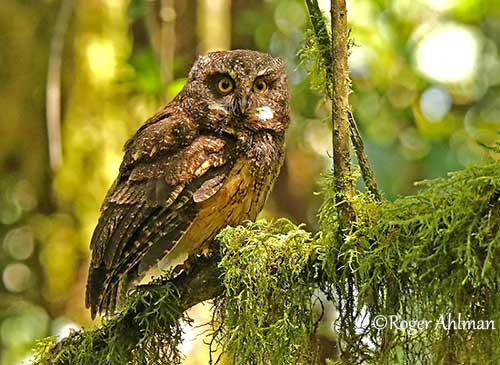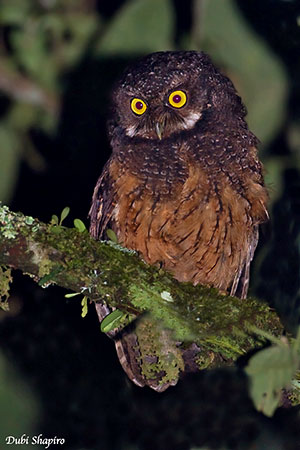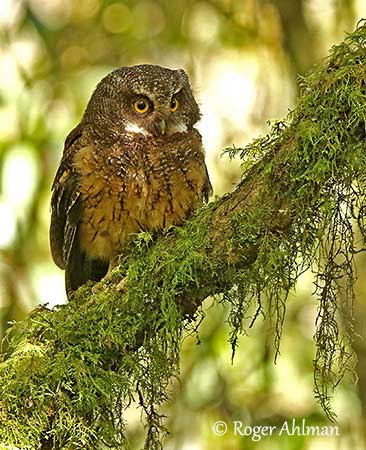
White-throated Screech-Owl
Megascops albogularis
Strigiformes Order – Strigidae Family
INTRODUCTION:
The White-throated Screech-Owl is found from N Colombia S to C Bolivia. It is mainly found on the East slope of the Andes. It is widely distributed but generally uncommon, often detected only by its song.
It frequents humid montane evergreen forest and cloud forest, and mainly open forests and edges. It can be seen at high elevations, up to 3,700 metres in Peruvian Andes. This nocturnal species feeds primarily on insects and other arthropods, and probably takes small vertebrates.
The population of the White-throated Screech-Owl is suspected to be stable and the species is described as “locally fairly common”.
DESCRIPTION OF THE BIRD:
Biometrics:
Length: 20-27 cm
Weight: 130-185 g
The White-throated Screech-Owl is a fairly large dark owl with contrasting white throat giving the bird its name.
Upperparts, head and breast are dark brown with fine white and buff speckles. Flight-feathers and rectrices show narrow white barring.
On the underparts, the white throat may appear as two large moustaches, depending on head posture. The breast is dark brown with tawny spotting. Belly and lower underparts are tawny-buff with sparse dark brown streaks.
REPRODUCTION OF THIS SPECIES:
The breeding season appears to be variable according to the range.
The White-throated Screech-Owl may nest on the ground among grass and ferns, but it also uses abandoned nests of other species, often open structures placed in bushes or trees. Like numerous Strigidae, it probably also uses tree holes if available.
One incubated egg was found in a deserted cup-shaped nest placed above the ground.
No other information.
PROTECTION / THREATS / STATUS:
The White-throated Screech-Owl is described as “fairly common” in Ecuador and Peru. But the species could be overlooked in other regions.
The population is suspected to be stable.
The White-throated Screech-Owl is not globally threatened, and currently evaluated as Least Concern.
Fr: Petit-duc à gorge blanche
Ang: White-throated Screech-Owl
All: Weißkehl-Kreischeule
Esp: Autillo gorjiblanco
Ita: Assiolo golabianca
Nd: Witkeelschreeuwuil
Sd: vitstrupig skrikuv
Photographers:
Roger Ahlman
Pbase Galleries Peru and Ecuador & My bird pictures on IBC
Dubi Shapiro
Dubi Shapiro Photo Galleries & Dubi Shapiro's Pictures on IBC
Text by Nicole Bouglouan
Sources:
HANDBOOK OF THE BIRDS OF THE WORLD Vol 5 by Josep del Hoyo-Andrew Elliott-Jordi Sargatal - Lynx Edicions - ISBN: 8487334253
OWLS OF THE WORLD – By Claus König, Friedhelm Weick and Jan-Hendrik Becking - IBSN 978-0-7136-6548-2
BIRDS OF PERU by Thomas S. Schulenberg, Douglas F. Stotz, Daniel F. Lane, John P. O’Neill, Theodore A. Parker III – Princeton University Press 2007 – ISBN:978-0-691-13023-1
A GUIDE TO THE BIRDS OF COLOMBIA by Steven L. Hilty and William L. Brown - Princeton University Press – ISBN 069108372X
Neotropical Birds – Cornell Lab of Ornithology

The large, rounded head is dark brown and fluffy-feathered. The ear tufts are almost invisible. The facial disk is mostly dark. We can see a narrow whitish stripe above and below each eye. The narrow white throat patch is conspicuous.
The bill is greenish yellow to greenish grey, including the cere. The eyes are orange-yellow. The tarsi are fully feathered whereas the bare toes are pale yellow to brownish-flesh.
Male and female are similar.
The juvenile is buffy white to pale buffy grey. It has a black mask formed by orbital disks and long bristles above the bill. Crown, mantle and underparts are barred dusky.
SUBSPECIES AND RANGE:
The White-throated Screech-Owl has five subspecies.
M.a. obscurus occurs in Sierra de Perijá, on the N Colombia/NW Venezuela border.
This is the darkest race with black upperparts with some white and rufous spots, and dark breast with almost uniform underparts.
M.a. meridensis is found in the Andes of W Venezuela.
This one has whitish forehead and eyebrows, pale spots on upperparts forming an indistinct nuchal collar, and paler belly than nominate.
M.a. macabrus is found in C and W Andes from Colombia to Ecuador, S to N Peru (Cajamarca).
This one resembles nominate but the underparts show finer pattern.
M.a. albogularis (described above) occurs in E Andes of Colombia and Ecuador.
M.a. remotus is found in E Andes from Peru S to C Bolivia (Cochabamba).
This race is the darkest, with M.a. obscurus, and both are very similar.
HABITAT:
The White-throated Screech-Owl frequents mainly forest borders and open woodlands, but also semi-open areas with scattered trees. It is usually found in habitats where epiphytes and bamboos are present.
This species is usually seen between 2,000 and 3,000 metres of elevation, although it may occur locally down to 1,300 metres, or much higher up to 3,700 metres in Peruvian Andes.

CALLS AND SONGS: SOUNDS BY XENO-CANTO
The White-throated Screech-Owl is often detected by its song. The male utters a series of gruff, barking sounds, often during one minute and given continually “churrochurro-churro-gugugugugugug”. It also produces more spaced hoots descending gradually, described as a descending trill of 10-17 clear notes “hu hu hu hu hu…”
Both mates may sing in duet during which the female responds with slightly higher-pitched notes “wubububububububu”.
BEHAVIOUR IN THE WILD:
The White-throated Screech-Owl feeds mainly on insects and various other arthropods, and it probably takes small vertebrates too.
It is crepuscular and nocturnal like numerous Strigidae, and hunts in the canopy. But this behaviour requires more information.
In the same way, the breeding behaviour is poorly known. The duets performed by both mates can be heard during the breeding season, whereas the long series produced by the male is identified as territorial song.
The owls generally perform some aerial displays and sing. Courtship feeding by male to female usually occurs too.
The White-throated Screech-Owl is apparently resident, but it may make seasonal movements to higher elevations.
The nocturnal owls have silent flight when hunting.
